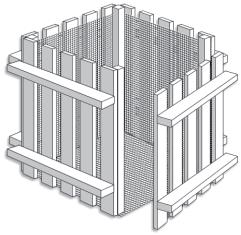One of the most common concerns that new composters have is whether their compost bin will attract unwanted pests like mice and other undesirable visitors. Flies and other insects hovering around your compost pile can also be a source of concern.
The best defence against these pests is to simply follow the basics. Here are some reminders and a few suggestions to help you avoid problem guests:
- Never put meat, bones, fats, dairy products, or animal waste into your compost pile. The odour from these can be very attractive to rodents.
- Place a layer of dry leaves or other “brown” on the bottom of your bin. This will provide for good drainage along the bottom of the pile.
- Place your compost bin in a well drained area with at least partial sunshine.
- Don’t leave fresh scraps exposed, always cover them with a layer of “browns.” (leaves, dry grass, etc) These materials will absorb odours and also help micro-organisms to get to the material faster.
- Don’t let your pile get too dry. Keep each layer damp to discourage nesting. Keep your pile well aerated. Turn the pile once a week, if possible, using a pitchfork or use an aerating tool to create air channels throughout the pile. Aerating the pile will also help reduce odours that might attract pests.
- Harvest finished compost when it is ready to discourage pests from nesting in the finished compost.
For more details on the above, visit our composting program information.
A note about insects: Remember that insects like centipedes, spiders, beetles, and earthworms are vital to the compost process. These insects help break down the organic waste into smaller pieces for micro-organisms to digest. Generally, the heat of the compost pile keeps the insect population in check.
Pest Proofing
In the event that despite following the basics of composting you end up with unwanted guests, you can always consider “pest proofing” your bin:
- Commercially available plastic bins are relatively pest-proof to begin with. However rodents can still burrow underneath and access your bin from below. Putting a layer of 1/4″ wire mesh / hardware cloth under your bin can help prevent this from happening. Chicken wire is not a good choice as the holes are too large and will not keep out smaller rodents.
- Pest proofing a wooden bin is a bit more challenging. The best time to pest proof is when you first build your bin, however in most cases you will have to remove all the material from your bin before starting. You can then line the sides and bottom with 1/4″ hardware cloth. You can attach the mesh to the bin with a heavy gauge staple gun or you can secure it with 2 X 2 posts screwed or nailed into the corners of the bin. The biggest challenge is ensuring that all the joints/corners of the wire liner are secure. Make sure to overlap the mesh and secure it together with either wire or zip ties.

If your wood bin has a removable front panel, you will need to ensure that there is sufficient overlap of the mesh in these areas to ensure that rodents cannot get through. If you also choose to put a wire mesh top on the bin, you will also have to ensure that there are no openings in the corners or along the sides that would allow pests to crawl in.
Still more questions? : Call the Compost Info-Line: 204 925 3777 ext 1 or Toll-Free 1 866 394 8880, or send us an email!




Recent Comments